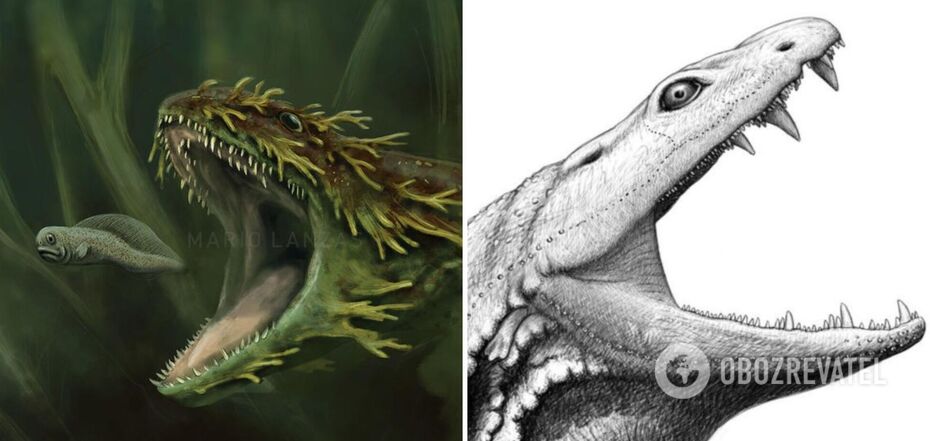Life
"Tadpole from hell", which terrified the Earth long before the dinosaurs, showed its face for the first time
For the first time in almost a century of research, scientists have managed to reconstruct the skull of Crassigyrinus scoticus (translated as fat tadpole), an animal similar to modern crocodiles that was one of the most fearsome predators 330 million years ago. Scientists unofficially call it a tadpole from hell.
The study, which made it possible to recreate the appearance of Crassigyrinus scoticus, is reported in the scientific journal Journal of Vertebrate Palaeontology. The researchers dedicated their work to the professor and pioneering paleontologist Jenny Clack, who revolutionised the way people understand the evolution of early tetrapods. Clack was also a co-author of the study, but she died in 2020.
The problem with recreating the appearance of the ancient predator was that almost all of the found fragments of its skeleton were in very poor condition.
Crassigyrinus belongs to a group of four-legged animals that were among the first to leave the water for land. However, when other animals discovered the new world, the ancestors of Crassigyrinus either returned to the water or never went to land at all. This is how the predator appeared, living in coal bogs in modern-day Scotland and in some parts of North America.
"These animals have been preserved in fine-grained rock, which provides excellent contrast in computer scans. Unfortunately, it doesn't provide much structural integrity, so when more material accumulated on the surface of Crassigyrinus, it crushed the fossils," said Dr Laura Porro of University College London.
This led to the fact that scientists had a lot of bones of one creature, but it was quite difficult to restore its integrity. As SciTechDaily writes, despite the fact that some of the samples found were quite intact, they were either deformed or broken. Therefore, scientists spent a lot of time just trying to understand what was connected to what.
Despite this, they managed to establish that it was a four-legged, short creature. The only controversy was over the shape of the creature's skull.
Porro says that the scientists assumed that the animal had a narrow and high skull, like a moray eel. This assumption was based on a specimen in Edinburgh that was flattened from side to side.
"However, when I tried to mimic this shape using a digital surface from a CT scan, it just didn't work. There was no way that an animal with such a wide palate and such a narrow skull vault could have a head like that," the researcher explained.
Further attempts to reconstruct the creature's actual appearance resulted in a skull similar in shape to that of a modern crocodile.
"It had huge teeth and powerful jaws that allowed it to eat almost anything that came in its way," Porro said.
The true shape of the skull was restored thanks to computed tomography scans of four Crassigyrinus specimens.
"After we identified all the bones, it was like putting together a 3D puzzle," the doctor said.
She noted that because the scanned specimens had broken but not deformed pieces, the skull was reconstructed with a high degree of accuracy.
Scientists also managed to find out some of the characteristics of this creature.
The researchers are quite convinced that, despite its name, the fat tadpole was a dangerous predator.
Its body size reached 2-3 metres, which was quite large for the time. Porro believes that the behaviour of Crassigyrinus was similar to that of modern crocodiles, so it hid in muddy water, attacking other animals that had no chance of escape given the tadpole's powerful jaw.
The creature had large eyes, as well as lateral lines on its body that allowed it to capture vibrations in the water.
Also, a mysterious slit was found in the front of the snout, the use of which scientists do not know, but assume that it was a sign that the creature had other sensory organs.
"The nostrils were in other places, so there was a lot of speculation about what this hole could be," Porro explained.
One theory is that this opening helped the creature detect electric fields or different chemicals, as some fish and snakes can do today.
Scientists cannot be sure about this issue, as none of the living creatures "is so closely related to Crassigyrinus to know for sure."
"Obviously, these animals had very well-developed sensory organs, so it makes sense that they could have had another sense organ in the front of their face," the scientist concluded.
Earlier, OBOZREVATEL told about the mystery of the mysterious animal monster Tullimonstrum gregarium, which existed on Earth about 300 million years ago. Its amazing anatomy has stumped scientists for 70 years.
Subscribe to OBOZREVATEL's Telegram and Viber channels to keep up with the latest news.






























